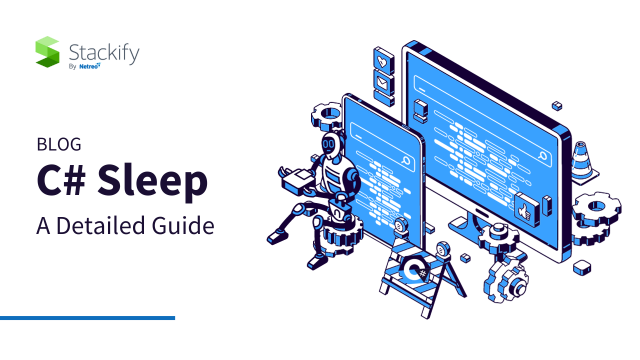
By TechnologyAzure and AWS Monitoring
By IndustryIntegrates with your stack
By InitiativeEngineering & DevOps Teams
TechnicalIt’s easy to get the help you need

Ah, the sweet allure of a well-rested application. No, I’m not talking about kicking back and letting your software take a nap. I’m diving deep into C# and its Sleep method.
Have you ever wondered, “Is there a Sleep function in C#?” We’ve got answers. By the end of this post, you’ll know all about the ins, outs and potential pitfalls of using Sleep in C#. So, grab your favorite beverage, and let’s get into it!
In the vast and varied landscape of C#, Sleep stands out as one of the pivotal methods provided by the Thread class. Nestled within the System.Threading namespace, this method might seem simple at a glance, but it’s a powerful tool in the hands of a seasoned developer.
At its core, the Sleep method is designed to pause or suspend the execution of the current thread for a specified duration, measured in milliseconds. It’s like telling a part of your program, “Hey, take a short break!” But why would you want to do that? Well, the reasons can be multifaceted, ranging from simulating delays to managing resource allocation.
However, it’s essential to understand that Sleep doesn’t make the entire application or process sleep. Instead, it halts only the specific thread it’s called upon. In a multithreaded environment, where multiple threads run concurrently, using Sleep on one thread doesn’t affect the execution of other threads. They continue to run unimpeded.
Consider this analogy to give you a clearer picture: Imagine a bustling kitchen with several chefs (threads) working simultaneously. If one chef decides to take a short break (sleep), it doesn’t mean the entire kitchen stops. The other chefs continue their tasks without interruption.
This distinction is crucial, because in modern software development, applications often rely on multithreading to perform multiple operations concurrently, enhancing efficiency and responsiveness. By selectively pausing specific threads using the Sleep method, developers can fine-tune the flow of their applications, ensuring that critical tasks get the CPU time they need while less crucial tasks can wait their turn.
Well, there are various scenarios:
So, why is it important? The answer lies in resource management. By controlling when and how threads execute, developers can optimize applications for performance and responsiveness.
Let’s get our hands dirty with some code!
Want to sleep for 1 second in C#? Here’s how:
using System.Threading;
// ... other code ...
Thread.Sleep(1000); // Sleeps for 1000 milliseconds (or 1 second)In this snippet, the Sleep method is called with a parameter of 1000, representing the sleep duration in milliseconds. So, the current thread will be paused for a second before it resumes its tasks.
Simple, right? Let’s move on to a more complex example.
Imagine fetching data from an API that allows five requests per minute. You might use Sleep to throttle your requests:
for (int i = 0; i < 5; i++)
{
FetchDataFromAPI();
if (i < 4) // To avoid sleeping after the last request
Thread.Sleep(12000); // Sleeps for 12 seconds between each request
}Check out this in-depth guide on C# threading and multithreading for more intricate threading scenarios.
While Sleep can be super handy, it’s not without its quirks.
While Sleep is great, there are situations where alternatives like Task.Delay or Timer might be more appropriate. For example, in asynchronous operations, Task.Delay allows for nonblocking waits.
Moreover, understanding the underlying mechanisms, like how C# handles reflection, can provide insights into optimizing your application’s behavior.
Understanding the mechanics of a feature or tool is undeniably essential. Still, the actual value emerges when we translate these technical nuances into tangible benefits for developers and end users. Let’s dissect the advantages of mastering tools like Sleep in C# and related monitoring tools.
By weaving together the technical understanding of methods like Sleep with comprehensive monitoring tools, developers can craft applications that aren’t just functional but are efficient, user friendly, and resilient. In this digital transformation era, where user expectations are sky-high, such mastery can be the difference between a good and genuinely great application.
This post was written by Juan Reyes. As an entrepreneur, skilled engineer, and mental health champion, Juan pursues sustainable self-growth, embodying leadership, wit, and passion. With over 15 years of experience in the tech industry, Juan has had the opportunity to work with some of the most prominent players in mobile development, web development, and e-commerce in Japan and the US.
Stackify's APM tools are used by thousands of .NET, Java, PHP, Node.js, Python, & Ruby developers all over the world.
Explore Retrace's product features to learn more.
If you would like to be a guest contributor to the Stackify blog please reach out to stackify@stackify.com